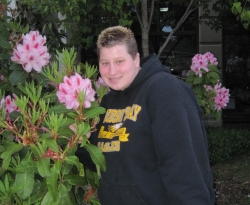In the week leading up to the Pride Parade in Seattle, we continue our series, “Participating & Proud.” YWCA Seattle I King I Snohomish staff and volunteers are participating in the parade this upcoming Sunday and we will take you through many of the reasons why it is important to do so. Members of the Lesbian Gay Bisexual Transgender Queer (LGBTQ) community are also members of our YWCA community and many of them face unique housing and homelessness challenges due to their sexual orientation and gender expression. The YWCA Seattle I King I Snohomish CEO, Sue Sherbrooke, believes, “Standing with our LGBTQ clients, staff, volunteers, board members and supporters is one concrete way we express our belief in the dignity and worth of every human being.” We hope this blog series is one more way that we can help take a stand and work towards ending homelessness for everyone.
Written by Nora Johnson, a Family Advocate at the YWCA I Seattle I King I Snohomish Family Village in Mountlake Terrace, and a member of the SO/GI committee.
As we consider the issues around homelessness and youth within the Lesbian, Gay Transgender, Bisexual, Queer (LGBTQ) Community, here are a few numbers from National Alliance to End Homelessness:
- 1.5 million American children become homeless each year.
- Many of these kids become homeless with their families, and others, mostly teenagers, flee their homes, choosing the uncertainty of street life over an intolerable life at home.
- The population of LGBTQ youth within the general population is estimated between, 4 and 10%, yet the percentage of homeless youth who identify as LGBTQ is conservatively estimated at 20%, with some research citing numbers as high as 40%.
- All homeless kids are extremely vulnerable to violence and exploitation, but those who identify as LGBTQ are twice as likely to be assaulted.
- Although the trauma of street life exacts a heavy toll on everyone who survives it, homeless lesbian youth, have a higher incidence of post-traumatic stress syndrome, conduct disorders, and substance abuse, and homeless gay males suffer from higher rates of depression, than their heterosexual counterparts.
- Finally, tragically, LGBTQ homeless youth are 31% more likely to attempt suicide than their heterosexual youth in similar circumstances.
These statistics offer us a grim thumbnail sketch of the combined effects of poverty, child abuse and homophobia. The often invisible children represented by these numbers deserve to be acknowledged, and responded to. The good news is that we at the YWCA are part of a dedicated network of shelter and advocacy groups working to end homelessness for everybody. Even better news is that shelter providers, youth advocates, and the greater LGBTQ community are taking bold steps to create safety for LGBTQ youth.
On the national level, groups like The Trevor Project and The It Gets Better Project are doing a great job raising awareness and reaching out to LGBTQ youth. Additionally, National Alliance to End Homelessness’s publication, National Recommended Best Practices for Serving LGBT Homeless Youth, provides guidance for making our programs safe and accessible.

Here in Western Washington we have several outstanding agencies that provide refuge and advocacy specifically for LGBTQ youth including Seattle’s ISIS House, a project of YouthCare, SnoGLOBE Equality Alliance in Snohomish County, and Oasis Youth Center in Tacoma.
Pride celebrates LGBTQ culture and community by promoting visibility and challenging assumptions. We have made some good progress this year, and we have a lot to celebrate. In the coming year let us harness the some of the energy generated by our revelries, and direct it towards most vulnerable members of our community. Let’s bring them home.